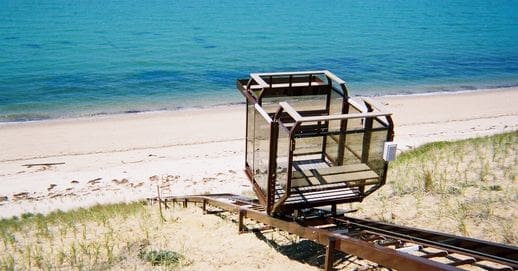
When constructing an inclined elevator, safety needs to be the absolute biggest priority considered in every detail and between every contractor involved. At Hill Hiker, we repeatedly exceed elevator safety codes for projects all around the world.
These are four components that we believe are essential to every inclined elevator.
Design & Quality Control
To start, an inclined elevator has to meet or exceed the North American elevator safety code ASME A17.1 / CSA B44 (5.4 (residential) or 5.1 (commercial)). Our staff is fully educated on this code and all that it entails.
The Hill Hiker inclined elevator product has gone through many engineering and safety code reviews to check for compliance and calculate safety factors on all structural and safety components of the system.
For example, our unique captured rail design, only found on Hill Hiker track systems, completely prevents the car and chassis from escaping or coming off the tracks. This design is unique to Hill Hiker and goes above and beyond the required safety code. Additionally, Hill Hiker, Inc. always follows the local building and electrical code requirements such as seismic design requirements for earthquake-prone locations.
Finally, quality control such as thorough testing and regular inspections during the manufacturing and installation process is essential and always performed by our highly trained production and installation managers, fabricators, technicians and mechanics.
Safety Brakes & Governor
Your inclined elevator needs to have a fail-safe electromagnetic motor brake that engages if power is lost. It also needs an overspeed governor with a dedicated mechanical chassis safety brake. The overspeed governor acts as a stop in case the elevator runs beyond its rated speed for any reason.
Your elevator lift system also needs a slack or broken cable stop switch and a dedicated mechanical chassis safety brake.
Hill Hiker uses proprietary broken rope/cable safety brakes and overspeed safety brakes and governor systems that are simple in design but extremely effective. This is how Hill Hiker has a perfect safety record after 25+ years in business and over 550+ systems installed.
Controls, Switches & Electronics
An emergency stop button needs to be both in the car and at all the landing stations. Security shut-off key switches or keypads need to exist to prevent unauthorized use. Mechanical style final termination switches are required to prevent over-travel of the elevator car.
Your inclined elevator also needs a car door and fixed landing gate electrical stop switches to prevent movement of the car if any doors/gates are open
The design and construction of the electrical components of the incline elevator are also regulated and must meet the safety code, electrical code and be UL listed (certified by the Underwriter Laboratory to meet the safety code).
Hill Hiker’s come with all these safety features plus all our control buttons and switches run on low voltage DC power to minimize shock hazard. All our electrical components including our main control panel have been UL listed and are designed for outdoor use with minimum IP67 or NEMA 4X weather ratings.
Quality Components & Construction
Hill Hiker provides full structural steel construction, oversized drive cables, stainless steel hardware, and many more quality components that affect the safety of your inclined elevator. We use curved inward handrails on our cars for additional safety, polycarbonate walls, door sill plates, and all the necessary safety signage that goes in the car.
Other safety features Hill Hiker provides are double reduction worm to worm drive gearboxes and ADA non-slip grate flooring in the car.
Learn more about Hill Hiker’s many safety features, check out our engineering and specifications, or view some of our options to customize your system. Our team is happy to help answer any of your safety-related or other questions.
Contact Hill Hiker, Inc. today for a free consultation and estimate.









